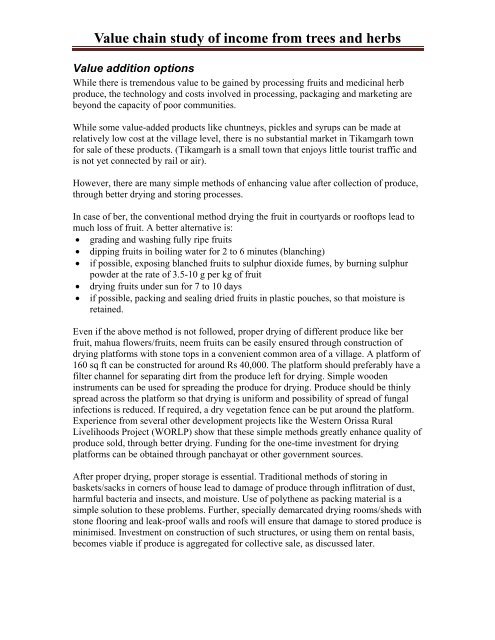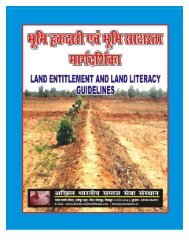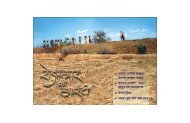Value chain study of income from trees and herbs - ABSSS
Value chain study of income from trees and herbs - ABSSS
Value chain study of income from trees and herbs - ABSSS
Create successful ePaper yourself
Turn your PDF publications into a flip-book with our unique Google optimized e-Paper software.
<strong>Value</strong> <strong>chain</strong> <strong>study</strong> <strong>of</strong> <strong>income</strong> <strong>from</strong> <strong>trees</strong> <strong>and</strong> <strong>herbs</strong><br />
<strong>Value</strong> addition options<br />
While there is tremendous value to be gained by processing fruits <strong>and</strong> medicinal herb<br />
produce, the technology <strong>and</strong> costs involved in processing, packaging <strong>and</strong> marketing are<br />
beyond the capacity <strong>of</strong> poor communities.<br />
While some value-added products like chuntneys, pickles <strong>and</strong> syrups can be made at<br />
relatively low cost at the village level, there is no substantial market in Tikamgarh town<br />
for sale <strong>of</strong> these products. (Tikamgarh is a small town that enjoys little tourist traffic <strong>and</strong><br />
is not yet connected by rail or air).<br />
However, there are many simple methods <strong>of</strong> enhancing value after collection <strong>of</strong> produce,<br />
through better drying <strong>and</strong> storing processes.<br />
In case <strong>of</strong> ber, the conventional method drying the fruit in courtyards or ro<strong>of</strong>tops lead to<br />
much loss <strong>of</strong> fruit. A better alternative is:<br />
grading <strong>and</strong> washing fully ripe fruits<br />
dipping fruits in boiling water for 2 to 6 minutes (blanching)<br />
if possible, exposing blanched fruits to sulphur dioxide fumes, by burning sulphur<br />
powder at the rate <strong>of</strong> 3.5-10 g per kg <strong>of</strong> fruit<br />
drying fruits under sun for 7 to 10 days<br />
if possible, packing <strong>and</strong> sealing dried fruits in plastic pouches, so that moisture is<br />
retained.<br />
Even if the above method is not followed, proper drying <strong>of</strong> different produce like ber<br />
fruit, mahua flowers/fruits, neem fruits can be easily ensured through construction <strong>of</strong><br />
drying platforms with stone tops in a convenient common area <strong>of</strong> a village. A platform <strong>of</strong><br />
160 sq ft can be constructed for around Rs 40,000. The platform should preferably have a<br />
filter channel for separating dirt <strong>from</strong> the produce left for drying. Simple wooden<br />
instruments can be used for spreading the produce for drying. Produce should be thinly<br />
spread across the platform so that drying is uniform <strong>and</strong> possibility <strong>of</strong> spread <strong>of</strong> fungal<br />
infections is reduced. If required, a dry vegetation fence can be put around the platform.<br />
Experience <strong>from</strong> several other development projects like the Western Orissa Rural<br />
Livelihoods Project (WORLP) show that these simple methods greatly enhance quality <strong>of</strong><br />
produce sold, through better drying. Funding for the one-time investment for drying<br />
platforms can be obtained through panchayat or other government sources.<br />
After proper drying, proper storage is essential. Traditional methods <strong>of</strong> storing in<br />
baskets/sacks in corners <strong>of</strong> house lead to damage <strong>of</strong> produce through inflitration <strong>of</strong> dust,<br />
harmful bacteria <strong>and</strong> insects, <strong>and</strong> moisture. Use <strong>of</strong> polythene as packing material is a<br />
simple solution to these problems. Further, specially demarcated drying rooms/sheds with<br />
stone flooring <strong>and</strong> leak-pro<strong>of</strong> walls <strong>and</strong> ro<strong>of</strong>s will ensure that damage to stored produce is<br />
minimised. Investment on construction <strong>of</strong> such structures, or using them on rental basis,<br />
becomes viable if produce is aggregated for collective sale, as discussed later.






